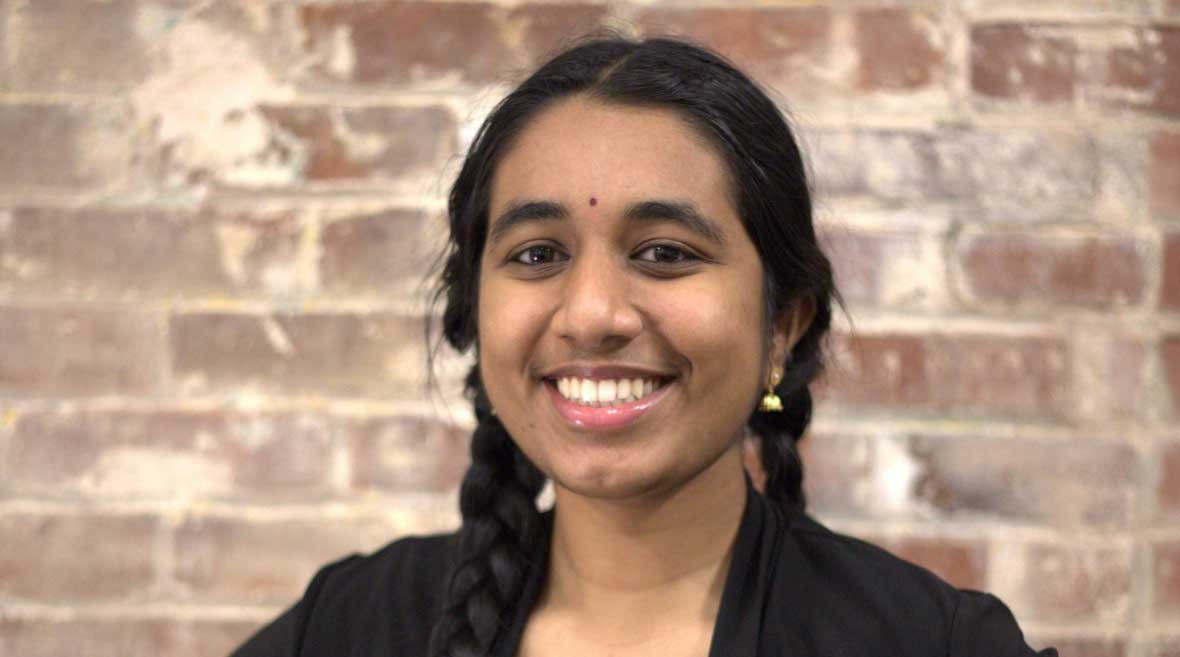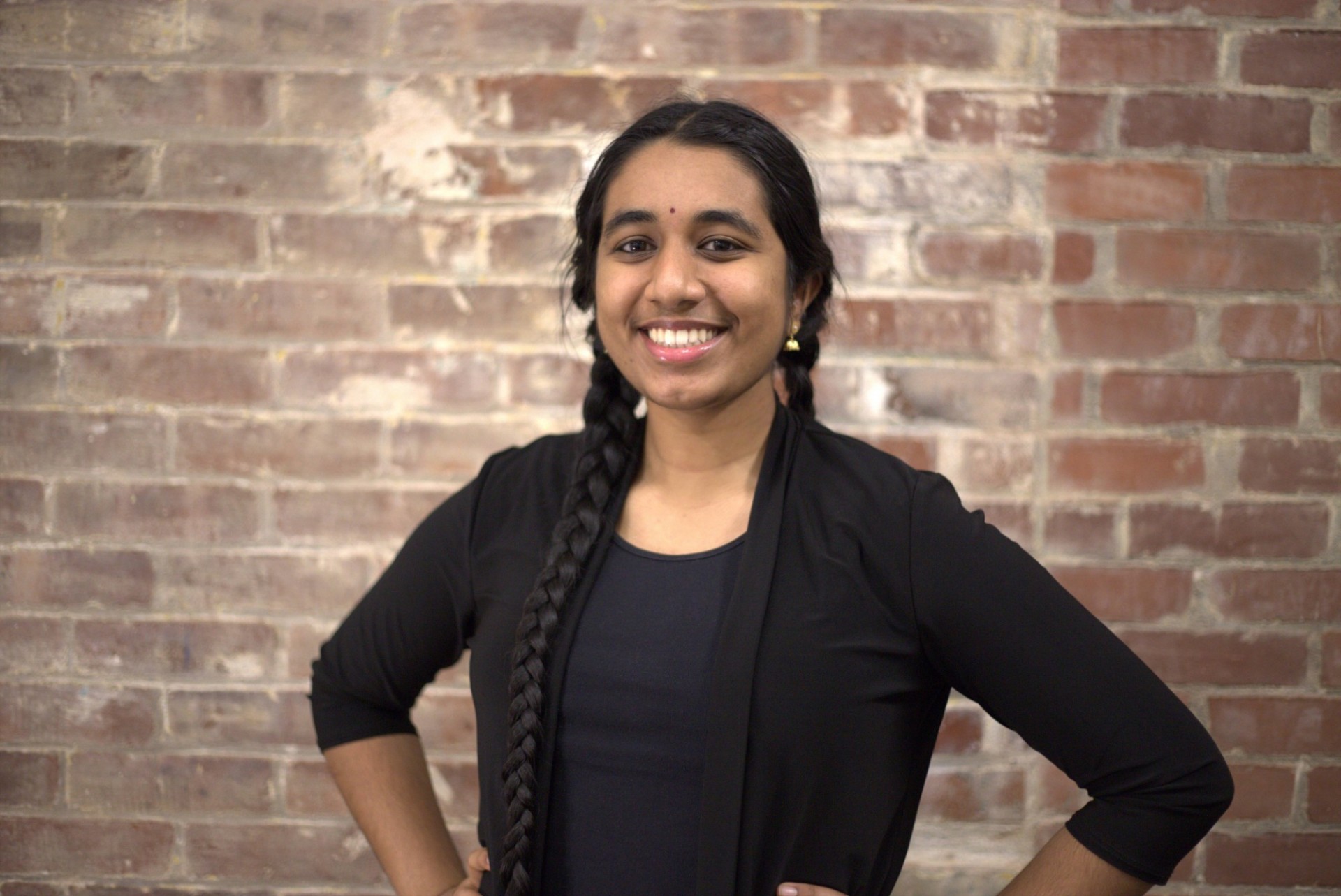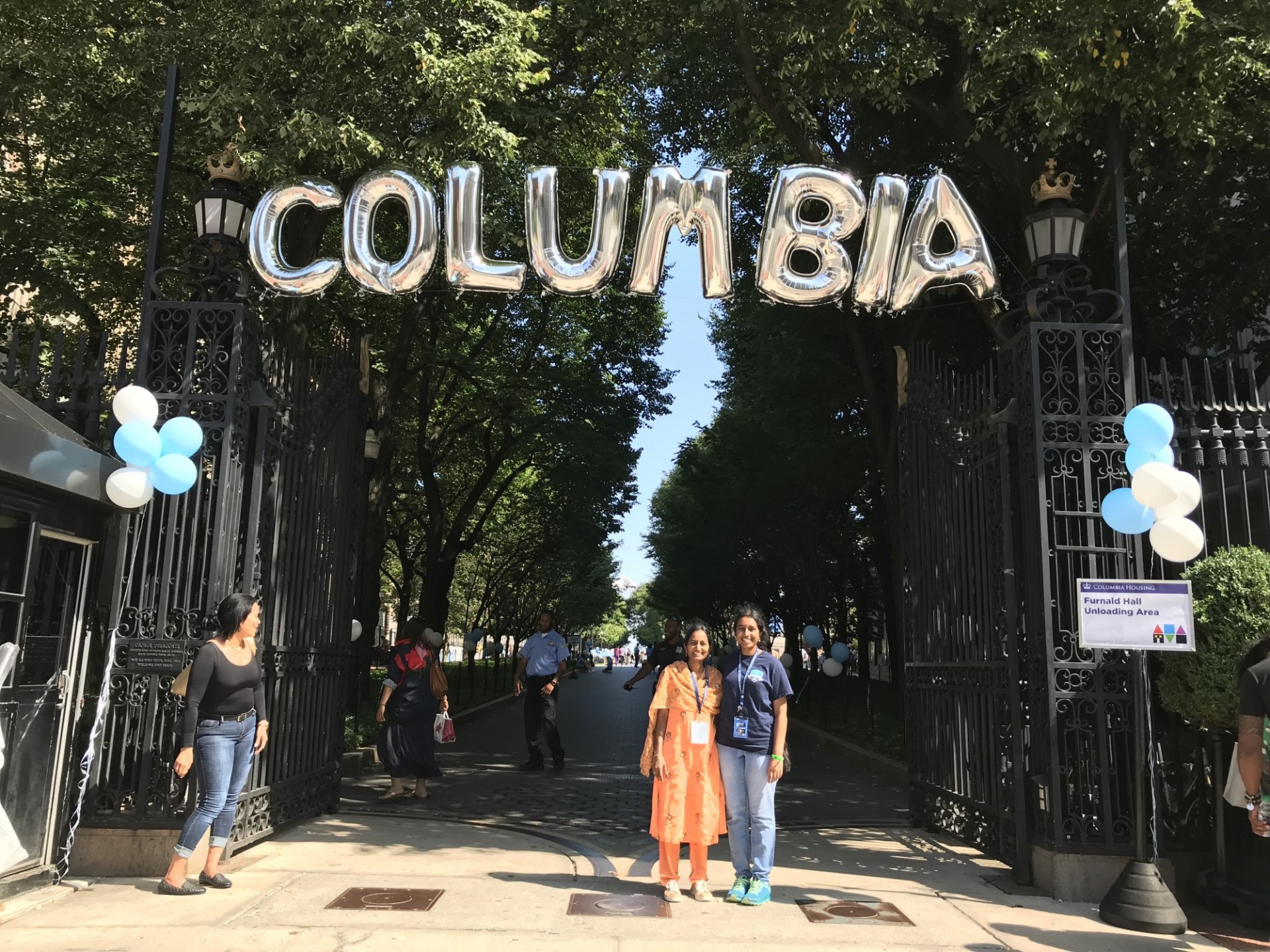One 2022 Graduate's Story of Her Time at Columbia and Beyond

Chinmayi Balusu (she/her) is graduating this Spring from Columbia College. Her time at Columbia has deepened her passion for neuroscience's intersections with other academic disciplines like public health, and her desire to focus on patient-centered clinical research. Along the way, she's launched a non-profit focused on supporting early neuroscience education, outreach and awareness.
Could you tell me more about your non-profit, Simply Neuroscience?
Even though I came across my interest in the brain back in middle school, the next steps involved a lot of trial-and-error, dead ends, and searching the Internet. Many of the resources I came across were specific to university students and experts, so for the most part, I was on a solo journey pursuing self-learning on platforms like Coursera. Especially as my parents immigrated from India and were unfamiliar with the American academic system, I was navigating a new higher education world while also trying to find where I belonged in the neuroscience space.
As I matriculated into Columbia, I started compiling all of the learning materials I had encountered along the way on a blog called “Simply Neuroscience.” As time went on, Simply Neuroscience gathered traction on social media and many fellow brain enthusiasts offered to contribute to the efforts. Three years later, Simply Neuroscience has grown into a worldwide non-profit organization dedicated to supporting early neuroscience education, outreach, and awareness – specifically for students!
Now, we have a rapidly growing team of 300 youth volunteers behind the scenes of the organization, and we support more than 25,000 middle school through graduate students in charting their own “brain” journey. Some of our initiatives include: the Action Potential Advising Program (connecting students to mentors for career guidance), the Synaptic Hacks hackathon (uniting youth for innovative neuroscience problem-solving), and The Synapse Podcast (sharing multilingual neuroscience news and showcasing undergraduate degree routes through guest interviews).
In addition to fostering students’ early explorations in neuroscience, Simply Neuroscience emphasizes the multidisciplinary nature of the field – combatting the perception that only science nerds and future brain surgeons can pursue neuroscience. From highlighting intersections of neuroscience with behavioral economics and cultural ethics to computational systems and architectural psychology, we’re building a more welcoming, inclusive atmosphere open to learning across traditional disciplines. We firmly believe that an interdisciplinary introduction to the field allows for critical thinking and creative synthesizing that is more reflective of neuroscience in the real world.
Overall, we are pursuing the brain and unlocking the future – one neuron at a time!
What ended up bringing you to Columbia?
At first, I was nervous about going to college on the opposite side of the country, but the Days on Campus experience for admitted students cemented my decision. I didn’t feel forced to pick and choose between varying identities and interests to fit in. I loved how much of an interconnected campus culture there was, with connections across the undergraduate and graduate schools as well.
And, New York City has truly been an immersive classroom! From being able to attend Broadway performances while writing about the intersection of medicine and theater in University Writing, or visiting the ancient Greek exhibits at the Met Museum while analyzing Homer’s Odyssey and Iliad during Literature Humanities, there is nothing quite like having Core Curriculum classes come to life right in front of your eyes. While applying to Columbia, I knew that these experiences would push me to think beyond my STEM horizons, but I was truly amazed at the flexibility and inspiration that they would grant me.
Tell me about your favorite experiences at Columbia.
At the heart of my Columbia memories is spontaneity – whether it’s sitting at the sundial and stargazing with my freshman-year roommate while listening to Frank Sinatra’s “Fly Me to the Moon,” meeting Contemporary Civilizations Zoom classmates for the first time in-person while in the Ferris pasta line, or bonding with my fellow River Hall residents in the rain during a fire drill.
I joined a group known as the Multi-Faith Fellowship (led by Religious Life) during my sophomore year, where we explored themes tied to heritage, spirituality, and philosophy across diverse community faith traditions on chilly Wednesday evenings. This was a great opportunity for me to reflect on my own identities as a Telugu-speaking Indian-American and Hindu, especially as I often pushed them to the back of my mind during the busy day-to-day student life. Furthermore, these discussions inspired me to propose a new campus-wide project through the Research Cluster on Science and Subjectivity: a lunch-and-learn series exploring the complex relationship between alternative medicine and heritage for members of the Asian diaspora. What is beautiful about the RCSS is that it is a community centered on exploring the parallels, reflections, and often swept-under-the-rug crossroads of science and the human experience. I’m hoping to officially launch my project during the fall 2022 semester – stay tuned!
Last but not least, an unexpected yet vibrant surprise was participating in the Core Centennial celebrations for Columbia College as well as the Mailman School of Public Health’s centennial anniversary. It’s amazing to think about how we are a part of living history!
What do you see for your future both at Mailman and beyond?
At the Mailman School, I will be building my background in neuroepidemiology, global health, science communication, medicine, and beyond. Columbia is one of the very few universities in the country that hosts a dedicated neuroepidemiology cluster, so I am especially excited to be a part of this novel learning environment.
My current research focus is on understanding the burden of neurological illnesses such as stroke and brain injury on an individual through a population scale. Brain injuries are unexpected and life-altering, and understanding the conditions involves an equal focus on patient narratives and cutting-edge scientific approaches. This is where a science communication and narrative medicine perspective enters the scene, as being an impactful public health and medical professional also means building empathetic and accessible connections with the communities we are seeking to support.
Looking to the future beyond Mailman, I’m planning to apply to medical school – and I hope to build a career that provides me the flexibility to engage with science and wellbeing from different academic and interpersonal perspectives!

Can you tell me a little about yourself?
My name is Chinmayi Balusu (she/her) and I’m a Medical Humanities major graduating from Columbia College this May. I’m originally from northern California but moved to New York when college started. During my time here, I have had an amazing time exploring the neuroscience scene, participating in innovative research firsthand, and getting involved in campus outreach activities through unique opportunities such as the Academic Integrity Undergraduate Advisory Board and Research Cluster on Science and Subjectivity. Following graduation, I will be continuing at Columbia’s Mailman School of Public Health uptown in Washington Heights and translating my academic interests there through the Master’s of Public Health program.
Could you tell me a little bit more about what you do at Columbia?
When I was applying to Columbia College, I thought I would declare as a Neuroscience and Behavior major. I loved how complex the anatomy of the brain was: how it seemed so confusing at first glance yet all connected together brilliantly. I was drawn to neurobiology during high school, but also strove to learn more about neuroscience applications outside of the STEM bubble during my time here, such as exploring cutting-edge neurotechnology startups and inspiring neuro-artworks. These wide-ranging curiosities also encouraged me to take a deep dive into the newly established undergraduate major known as Medical Humanities, pushing the boundaries of studying traditional medicine through anthropology, comparative literature, ethics, sociology approaches and beyond.
As a Medical Humanities major, I participated in my first nexus course titled “Pandemics: A Global History,” which catalyzed the journey of intertwining my diverse academic interests, rather than thinking of them as belonging to completely separate spheres. The connection between neuroscience and public health especially felt like a distant stretch at first, yet I began to piece together their relationship by visualizing real-world applications. For example, public health recommendations and interventions can play a role in promoting early brain health to reduce the risk of developing neurological conditions such as dementia and Alzheimer’s Disease later in life.
Outside of coursework, one valuable involvement was with a student organization called Columbia Synapse, which formally launched during my first semester here. I’m already feeling nostalgic as I say goodbye in a couple of weeks alongside fellow senior club members! Starting from humble roots in traumatic brain injury awareness, we have expanded over the years to advocate for invisible disabilities as well as inspire campus-wide discourse about neuroscience’s impact far beyond the research lab, classroom, and hospital. Being able to engage with students, experts, and advocates at the heart of Synapse is what inspired me to find parallels in my professional interests as well – seeking out the patient-centered encounters of clinical research and community-focused storytelling of science communication. In the end, it’s all about uniting people through understanding our common narratives!
Could you share a little bit more about your life before coming to Columbia, and how you ended up here?
I grew up in the suburban town of Folsom, California, which folks might recognize from Johnny Cash’s 1955 song! I was an absolute science enthusiast, participating in science fairs and organizing communities for young girls in STEM through organizations like 500 Women Scientists. But I also loved participating in activities like Hugh O’Brian Youth Leadership and National History Day documentary production that were a tad separate from my usual science world.
One of my favorite high school memories is from a ninth-grade class called AP Human Geography, which covered topics ranging from urban planning and political science to decolonization and environmental science. The course’s central focus was tying in current events to each unit’s learning targets, which put the topics into perspective and encouraged me to think about the interdisciplinary intersections and gaps in real time. In retrospect, all of these intersections seemed like the perfect primer for my Medical Humanities major!
Outside of K-12 school, I used to referee U12 soccer games, practice and train younger students at the local taekwondo dojo, spend time getting to know the senior citizens in my community, bike through nature trails, and garden and watch Telugu movies with my family on the weekends.

"As I matriculated into Columbia, I started compiling all of the learning materials I had encountered along the way on a blog called “Simply Neuroscience.” Three years later, Simply Neuroscience has grown into a worldwide non-profit organization dedicated to supporting early neuroscience education, outreach, and awareness that is specifically meant for students!" --Chinmayi Balusu, 'CC22
